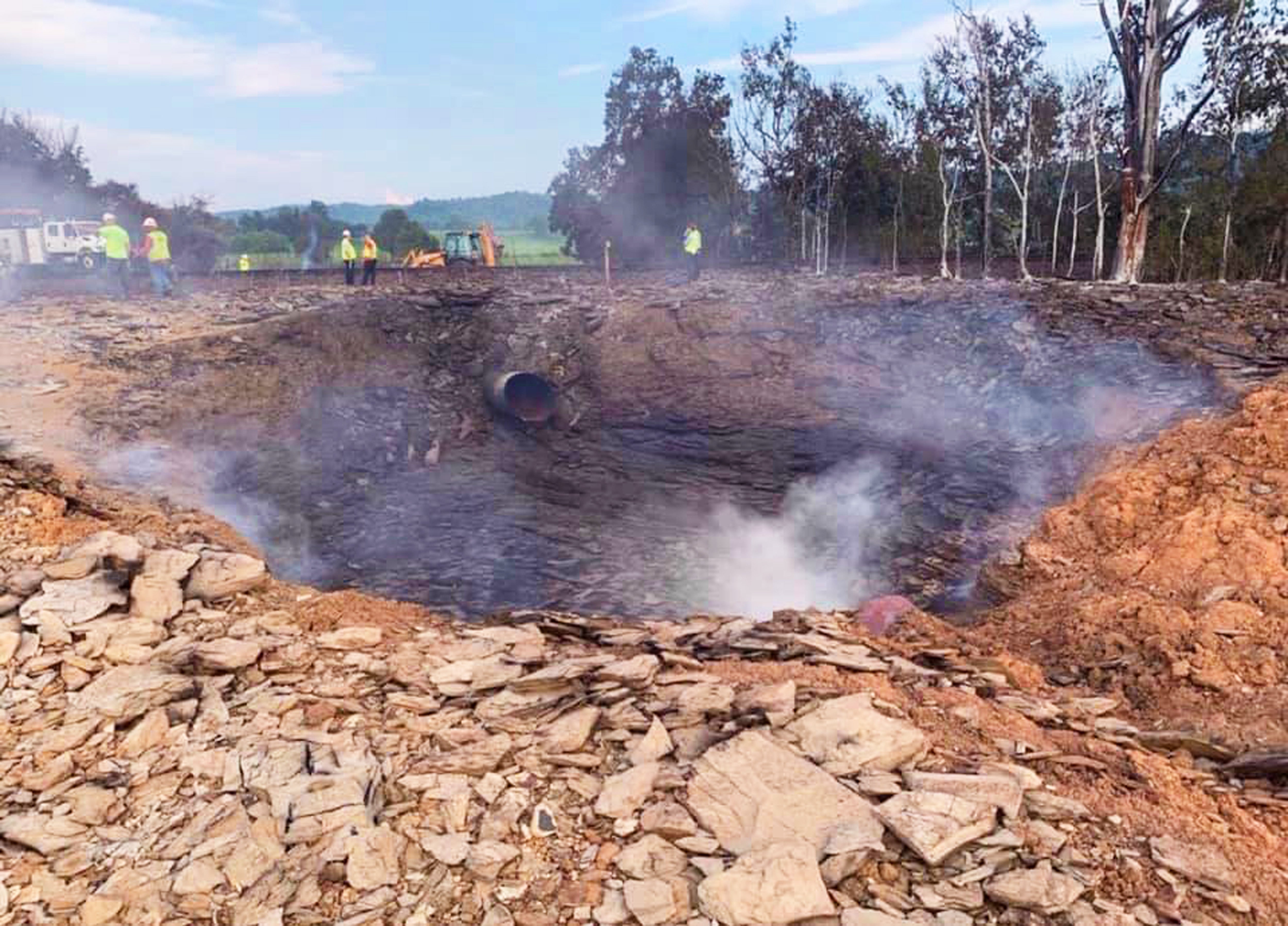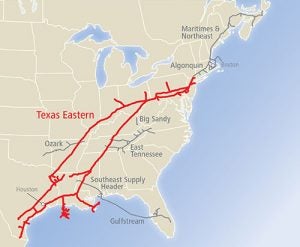Cause of pipeline explosion still a question. Preliminary findings list previous failures of same gas line
Published 7:30 pm Monday, August 26, 2019

- A photo of the massive crater left in the ground in Lincoln County after the gas pipeline explosion was taken by hazard materials specialists who assisted on the scene.(Photo courtesy of Somerset-Pulaski County Special Response Team)
Cause of pipeline explosion still a question
The cause of a fatal pipeline explosion in Lincoln County has not yet been determined, according to preliminary findings released by the U.S. Pipeline and Hazardous Materials Safety Administration (PHMSA).
The findings state the possibility of damage to two more gas pipelines that run near the line that exploded cannot be ruled out.
The pipeline exploded in the Indian Camp neighborhood in Moreland Aug. 1, killing one person and destroying five homes.
PHMSA’s findings are included in a corrective action order issued by the agency. They show that the blast blew 30 feet of pipeline out of the ground, resulting in a crater that is 50 feet long, 35 feet wide and 13 feet deep. PHMSA says it is estimated that 66 million cubic feet of natural gas was released by the failure, with the resulting fire destroying multiple structures and burning vegetation over approximately 30 acres of land.
The Texas Eastern transmission line is owned by Spectra Energy Partners, which is owned by Enbridge Inc., based in Calgary, Canada. The entire system is 9,100-miles long, carrying natural gas from northeastern America to the Gulf Coast region.
Line 15, the affected area, was constructed beginning in 1942, and is a 775-mile long bi-directional system that transports gas between Kosciusko, Mississippi and Uniontown, Pennsylvania. In the area of the explosion, Line 15 is one of three parallel Texas Eastern pipelines.
What happened
PHMSA says the failure happened at 1:24 a.m. Aug. 1. At 1:25 a.m., Enbridge’s Gas Control in Houston, Texas, received a rate of change alarm on Line 15, on the south side of the Danville Compressor Station. Then within minutes, public reports came in of a fire in the area. The report says a Danville Compressor Station operator also received the rate of change alarm and observed the rupture fire from the window of the compressor station control room.
During the minutes that followed, other Enbridge employees confirmed the reported fire, indicating the failure of Line 15.
Personnel at the compressor station then closed the line discharge valve, located north of the failure site. Texas Eastern field personnel responded by closing the Line 15 main block valve, then “further isolated a portion of the affected segment” and also shut down Lines 10 and 25, which it says were blocked in between the Danville Compressor Station and the Tompkinsville Compressor Station.
When the pipeline blew out of the ground, it landed approximately 460 feet from the failure site. Aside from the death of Lisa Derringer, 58, of Stanford, the explosion also resulted in the hospitalization of six people.

A map showing the Texas Eastern Pipeline. (Image from enbridge.com)
Firefighters from Lincoln County were the first to arrive on the scene, and approximately 75 people were evacuated from Indian Camp subdivision. Both Casey and Boyle counties’ emergency services transported some injured to Ephraim McDowell Regional Medical Center, while others were self-transported.
Findings show the failure site pipeline consists of .375-inch wall thickness, manufactured by A.O. Smith, using flash welding, and is coated with coal tar enamel, and cathodically protected with impressed current — meaning an electrical current is used to change the environment around the metal to stop corrosion.
PHMSA says the affected segment of pipeline “contains an as-yet-to-be-determined amount of A.O. Smith-manufactured pipe of similar vintage and type to the pipe involved in the failure.” It also says the cause of the failure has not been determined, and the National Transportation Safety Board (NTSB) is conducting a metallurgical investigation to determine the exact cause.
Other incidents
PHMSA says that on Nov. 2, 2003, Line 15 also failed near Morehead, between the Danville and Owingsville compressor stations, just north of Danville. The failure also occurred on A.O. Smith-manufactured pipe and “resulted from interactions between hard spots and mid-wall lamination.”
Texas Eastern reported it performed an in-line inspection to detect hard spots on Line 15 in 2011. It also reported it ran an inspection with a magnetic flux leakage tool in 2018, as well as with an inertial measurement tool this year. PHMSA says the ‘18 inspection “indicated a small dent with metal loss that did not require action under federal pipeline safety regulations” or Texas Eastern’s procedures.
The results of this year’s in-line inspection have not yet been provided to the PHMSA.
According to the NTSB, the Texas Eastern Pipeline also exploded in ‘85 in Beaumont, Kentucky, and in ‘86 in Lancaster, killing and injuring several. NTSB’s accident report concluded the one near Beaumont was due to “unsuspected and undetected” corrosion of the Texas Eastern Pipeline in the area, and said it was a “failure of the pipeline industry and of the Office of Pipeline Safety to recognize the need for and to require the use of in-line corrosion detection techniques.”
The cause of the incident near Lancaster “was the failure of Texas Eastern to fully investigate the extent and severity of previously detected … corrosion-caused damage and to replace the damaged segment of pipeline before its failure.” NTSB’s report also said “the lack of gas company guidelines for its personnel for further inspection and shut down or reduction in line pressure upon detecting corrosion damage on its pipelines” contributed to the incident.
Incident reports on the NTSB site, going back as far as‘86, show there have been 83 different incidents on the pipeline. In January, a pipeline on the same system exploded in Ohio. That incident is still under investigation.
According to PHMSA data, pipeline incidents have caused more than $8.3 billion in damages since 1999; more than $1 billion of those costs were in 2018. Since ‘99, it reports 11,993 incidents in the country, resulting in 318 fatalities and 1,304 injuries. These numbers are what environmental groups say should encourage the country to turn to a less volatile renewable energy source.
Required corrective actions
Enbridge Inc. spokesperson Michael Barnes supplied a “company update” which is posted to the the Enbridge website. It says crews continue to work in the area.
“Following a thorough evaluation to validate the integrity of the pipeline in compliance with regulatory requirements, Texas Eastern Line 25 — one of two pipelines adjacent to the impacted pipeline — has been returned to service. The reintroduction of natural gas into the pipeline was initiated after regulatory requirements contained in the corrective action order from the Pipeline and Hazardous Materials Safety Administration were satisfied, and it was deemed safe to proceed. We have been communicating with local residents, first responders and community leaders to provide updates on the work being performed.”
The two adjacent pipelines to Line 15 were taken out of service as a safety measure following the explosion. “Texas Eastern Line 10 and Line 15 remain out of service in the affected area, and the timeline for their return to service has not yet been confirmed.”
The corrective action order, issued by Alan Mayberry, associate administrator for pipeline safety with PHMSA, lines out the steps of shutting down the isolated section; enacting an operating pressure restriction; and a restart plan. It also says Texas Eastern must perform an aerial or ground instrumented leakage survey of the affected segment, and “remedy all leaks discovered.”
The order says that NTSB will perform mechanical and metallurgical testing, including failure analysis, then adds, “in the event the NTSB does not perform these functions, (Texas Eastern) will be responsible for completing all testing and analysis.”
Texas Eastern is also required to “review and assess the effectiveness of its Public Awareness Program with regards to the failure.” A remedial work plan will be required, and the company must submit a corrective action order documentation report, including “lessons learned while completing this order.”






